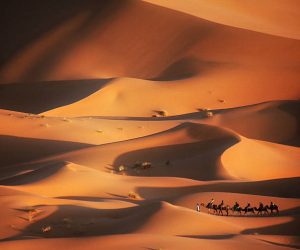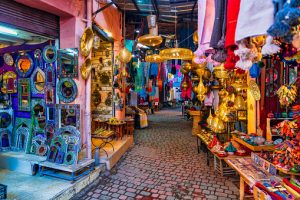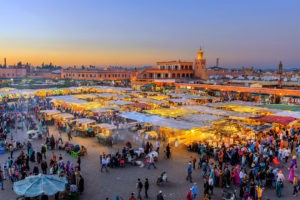Imperial cities of Morocco – Morocco Imperial cities Tours Guide info:
Imperial cities of Morocco are the four cities that have been the capital of Morocco during the Moroccan dynasties: Fes, Marrakesh, Rabat and Meknes.
Rabat, Marrakesh, Fez and Meknes are Morocco’s four imperial cities and visitors can enjoy getting lost amid their maze-like medinas, which have been made UNESCO World Heritage Sites.
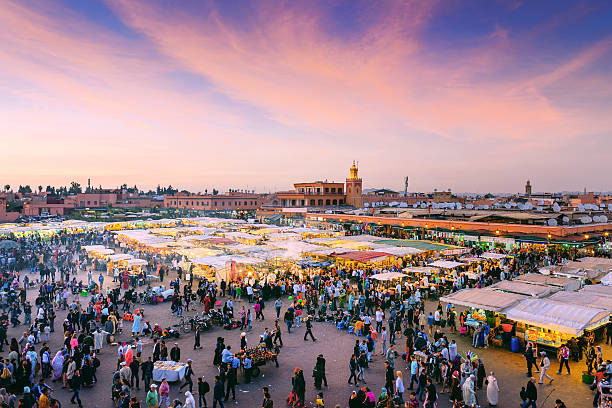
Fes:
History of Fes:
The city ‘Medina Fez’ was founded by Sharif Alid Idris I in 789 where the current Andalusian district is located. In 808, the Regent Rashid Ben Morshid founded ‘al-Aliya’ on the other edge of the river. Al Aliya developed quickly and became a real city with a mosque, palace and kissariya (market).
From 817-818 nearly 800 Andalusian families, expelled by the Umayyad from Cordoues suburbs (currently in Spain), settled in the city, followed shortly by 200 families who were banished from Kairouan (currently in Tunisia). They settled on the al-Aliya bank.
The Quaraouiyine university was founded in 859 by Fatima al-Fihriya, the daughter of a wealthy merchant from Kairouan. The university became one of the most important spiritual and cultural centers of the time and played a part in the intellectual golden age of Islamic civilization.
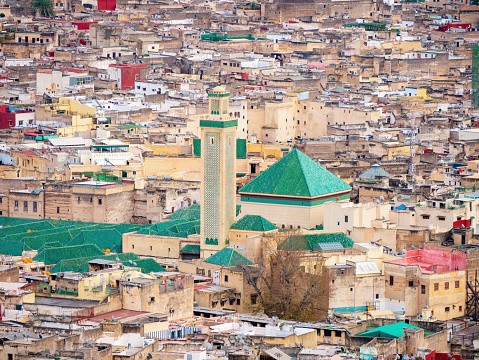
Fes Travel Guide
Fes – or Fez – was founded in the ninth century (789) under the reign of Moulay Idriss Ist. This great city is home to the world’s oldest university, the Qarawiyyin university. The city peaked in the thirteenth and fourteenth centuries, under the Marinids, when it replaced Marrakesh as the capital of the kingdom.
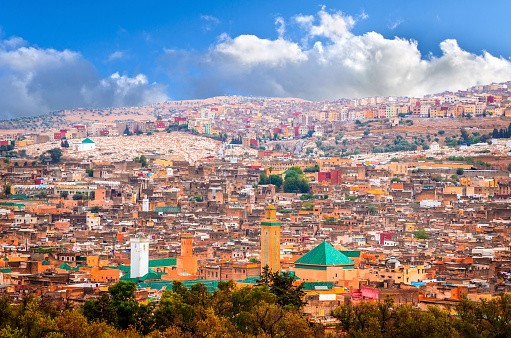
Travel to Fes Morocco: Getting there
By Plane
International Fes Saïss airport is located 14 kilometers south of downtown. This is one of the most utilized airports in Morocco. Once you leave the airport, take a taxi (white) or a shuttle bus that connects the city center to the airport. The bus (line 16) cost only 4 Dirhams (leaves every hour). You can take a taxi but it cost more (150 Dirhams : (17$).
By Train
There is a regular train service and prices are cheap.
- From/to Rabat : 2 hours 40 minutes
- Casablanca : 3 hours 20 minutes
- Marrakesh : 7 hours 30 minutes
By Bus
There are buses to all destinations with very reasonable prices. We recommand ‘CTM’ or ‘Supratours’. The CTM Bus station is in place Allal el-Fassi.
By Car
All major cities in Morocco are accessible via the highway from Fes which is connected via the A2 highway to Meknes, Rabat, Casablanca and Marrakesh.
Places to visit in Fes
Medina of Fes
The Medina is one of the best preserved historical towns in the Arab-Muslim world. You can walk around the city through the gates of Bab El Guissa in the north east, Bab Ftouh, east on the road of Taza which leads besides the thermal baths of Sidi Harazem, Bab Jdid, which is the nearest gateway to access the souks and Bab Boujloud to the west.
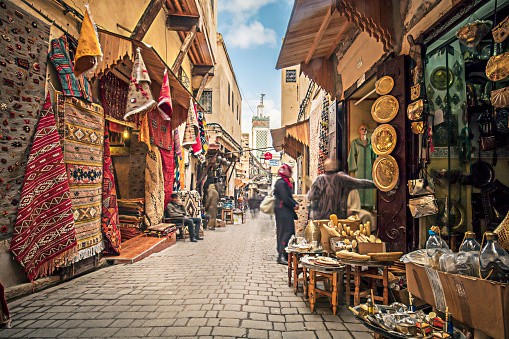
Fes el-Jadid & Fes el-Bali
Fes el-Jadid and Fez el-Bali form the Fez medina, a UNESCO World Heritage Site.
Fes el-Jadid: built in the thirteenth century by the Merinides is an administrative area
Fez el-Bali: the oldest part, built by Idrissids.
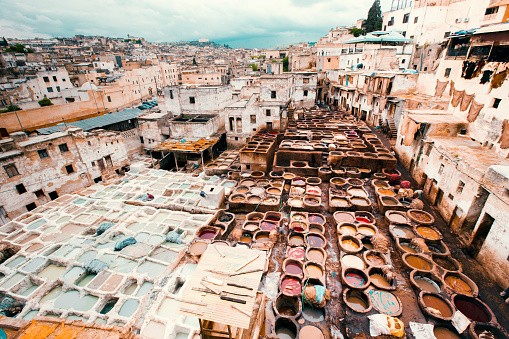
Al-Qarawiyyin Library
Visit the oldest Library in the world. After three years of restoration the building is now open for visitors. It is the emblem of the city and its architecture is one of the best representatives of the Arab-Andalusian style.
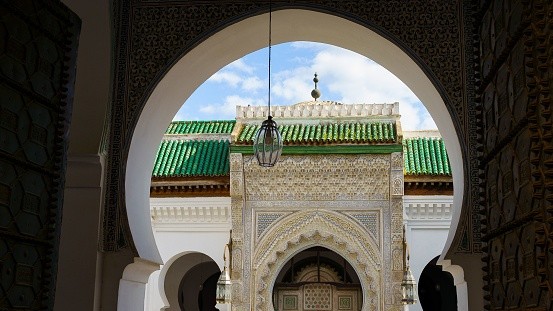
Jardin Jnan Sbil
Created in the eighteenth century by Sultan Moulay Abdallah, Jnan Sbil is the oldest public garden in the city. It is renowned for its variety of plant species and water supply infrastructure.
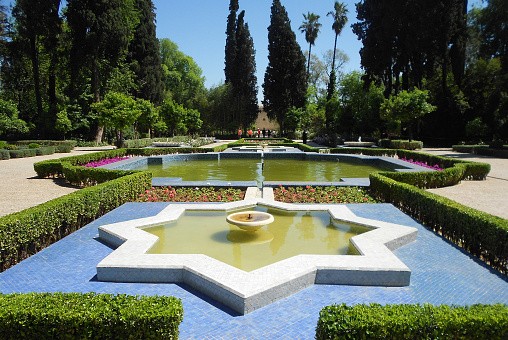
Bou Inania Madrasa
Bou Inania Madrasa is a madrasa (educational institution) built in Fez, retaubed between 1350 and 1355 for Sultan Abu ‘Inan Faris. The facade of the madrasa has a very complex model of a water clock, a unique system that allowed to precisely knows the prayer times.
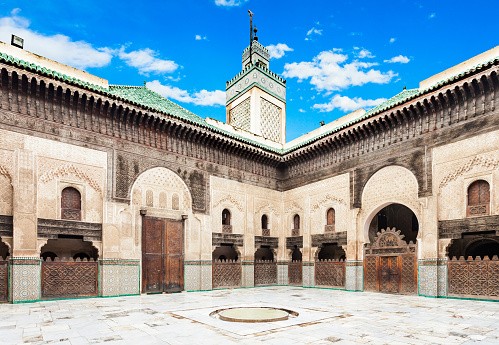
Moulay Abdellah Quarter
This is where men work tanning and dyeing leather.
They begin by cleaning the skin in pools of lime and ammonia fumes then color them and finally dry the cow goat /sheep hides on roofs.

Attarrine Madrasa
Madrasa Attarine is a former Koranic school in Fez. It was built between 1323 and 1325 by the Marinid sultan Abu Said Othman. It takes its name from the nearby perfumes and spice souk.
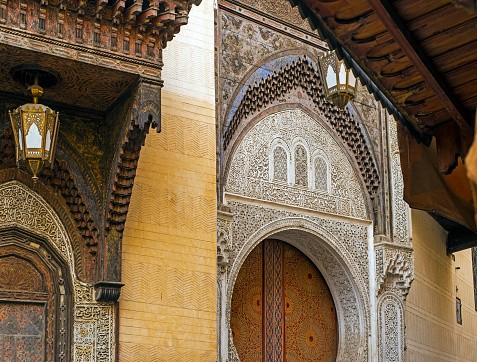
Bab Boujloud
A beautiful monumental gate, built in 1913, composed of three symmetrical horseshoe arches embellished with rich decorated tiles in blue tones. Bab Bou Jeloud Gate is also known as Bab Boujloud or ‘The Blue Door’.

Museums
Nejjarine Museum of Wooden Arts and Crafts
Built in the eighteenth century as a trading point for these precious items, this monument over three floors, has recently been beautifully restored.

Batha Museum
This museum was a palace in the 19th century, but now you can find a lot of traditional Moroccan arts and crafts as well as a superb ceramic collection dating from the 14th century.
Marrakech:
Marrakech History
Marrakesh was founded in 1062 under the reign of the Almoravid King Yusuf ibn Tashfin. Quickly many mosques and madrassas were built and the city became a major center for traffic between the western Maghreb and sub-Saharan Africa.
Many palaces were built using Andalusian craftsmen from Córdoba and Seville, who brought the Umayyad style characterized by carved and lobed arched domes.
In 1122 the city was fortified by walls by the son of Youssef Ibn Tachfine Ali Ben Youssef.
In 1147 the Almoravid lost the city against the Almohad and almost all the monuments and palaces were destroyed by the Almohads as they considered the Almoravid to be heretics. In 1184 they built the impressive Koutoubia Mosque on the ruins of an Almoravid Palace.
In the sixteenth century Marrakesh became the capital of the Saadian Empire and the city was embellished and restored during the reign of Ahmed Al-Mansur Ad Dhahbi (‘the golden’ in Arabic) who brought more than half a ton of gold from Timbuktu (Mali). This gold was partly used to build the sumptuous El Badi palace.
After the end of the Saadi Dynasty in 1659, the Alaouite dynasty took control over Morocco and Meknes became the new capital of the Empire.
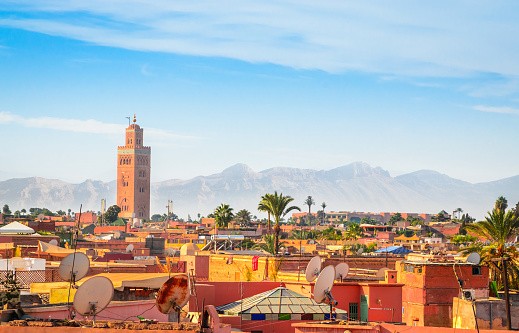
Marrakesh Travel Guide & Marrakech Tour Guide
Getting there : Travel to Marrakech & Ways to Get Marrakech
By Plane
Marrakesh has an international airport with plenty of low cost carriers flying there.
You can take a white taxi but forget your hang-ups and start haggling to get a best deal. The airport is about 5km from the city, you can offer 50 Dh to the taxi driver (the usual price is 70 Dh to the airport and 100 Dh the other way) if he refuses you can take a bus (N°19) departure every 30 minutes from 07:00 AM to 09:30 PM, the bus ticket price is 30 Dhs.
If you are not in a hurry and want to save money here is a tip:
- Walk 5 Minutes from the Airport terminal. (Click on the image for a larger view)
- Rise your hand to call taxis (beige colored) : Max 3 people per taxi.
- If another client is already in the taxi ask the driver if he is going close to your destination.
- Ask the driver to use the counter!
- With light traffic it should not cos you more than 25 Dhs whether you are alone, 2 or 3 People!
By Train
Marrakesh is connected with most cities in Morocco. It takes 3 hours 20 minutes from Casablanca and 4 hours 20 minutes from Rabat
By Bus
You can buy ‘Supratours’ tickets from the Supratours office inside Marrakesh railway station. You can buy CTM bus tickets form the new bus station just near the Supratours station called in French ‘Gare Voyageur’.
Places to Visit in Marrakech & Marrakech Tour Guide
Jemaa El-Fnaa
Jemaa El-Fnaa square is located in the southwest of the medina. This popular and lively place has become one of the symbols of the city since it developed in the 11th century.
The place has been part of the UNESCO World Heritage site since 1985 and you will find variety of activities such as fortune-telling, Gnaoua dancers, storytellers, henna tattooing, water-carriers (called ‘Grrab’ in Moroccan) and of course many restaurants, fresh lemon and orange drinks. If you are brave enough try the snail soup, it’s very good.

The Medina of Marrakech
Near Jemaa El-Fnaa you will find many souks so don’t hesitate to bargain. This is something very particular in the Moroccan culture, for example if the price is 200 Dhs start low and offer 100 Dhs if the merchant refuse you can either increase your bid or walk away. If the vendor really want to sell to you he will ask you to stay and will either accept your offer or give his final price.

Koutoubia Mosque
The Mosque was built on the ruins of an Almoravid Palace by the Almohad dynasty in 1184 and finished in 1199. The tower of the mosque served as model for the Giralda tower in Seville (Spain) and for the Hassan Tower in Rabat.
The minaret is 77 metres height (69 without the spire) and the mosque is located 300 meters west of Jemaa El-Fnaa
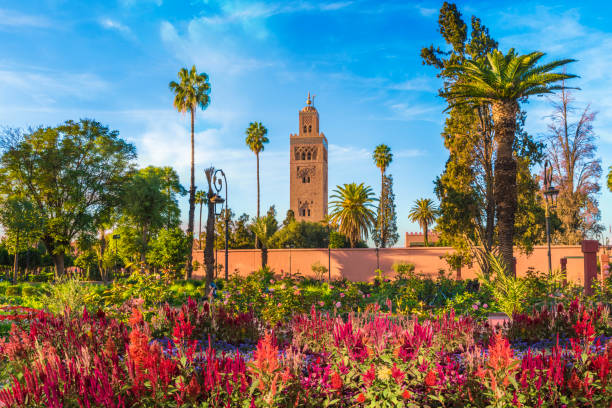
El Badi Palace
This ruined palace was built by Ahmad Al Mansur Ad-Dhahbi in 1578 and took 25 year to build. It was the most beautiful palace in Morocco with only rare and expensive materials being used, such as marble from Italy, gold powder from West Africa, porphyry from India and also Jade stone from China.
In 1695 the Sultan Moulay Ismail ordered the transfer of the most valuable materials from El Badi Palace to Meknes.
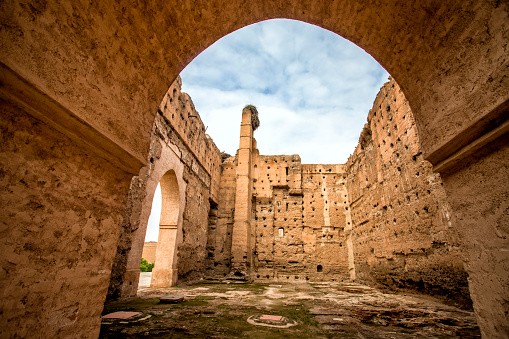
Bahia Palace
This palace was built in 1866 by ‘Si Moussa’ the chamberlain’s of Sultan Hassan 1st. The chamberlain son Ahmed ben Moussa extended the palace during his reign as regent, he lived with 4 wives and 24 concubines of his harem. The name of the palace is named after one of his favorite mistress; Bahia.
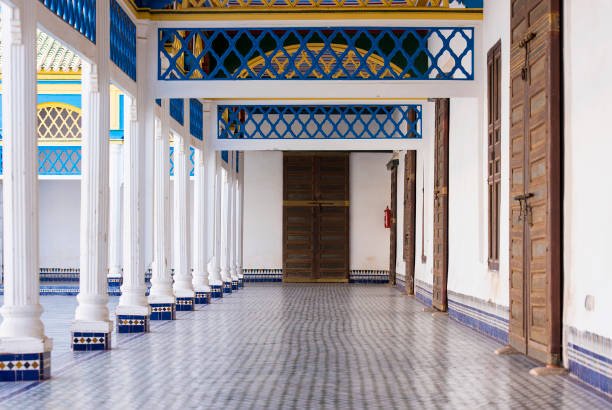
Qubba el-Baadiyn
The qubba meaning ‘dome’ is a religious building built in 1117 by Ali Ben Youssef. This is the last vestige of the Almoravid dynasty, the others buildings having been destroyed by the Almohad dynasty.
The dome is located just opposite the entrance to the Ben Youssef Mosque and a few meters from the Marrakesh museum.
Saadian Tombs
These tombs date from the time of the Sultan Ahmad Al-Mansour Ad-Dhahbi (Reign 1578-1603) of the Saadi dynasty. The tombs where rediscovered in 1917 by the French. About sixty Saadians are buried there, including Al-Mansour, his successors and his family. The building was lavishly decorated with finely worked cedar wood, floral motifs, calligraphy and marble from Italy.
Outside, are the graves of soldiers and servants, and the garden of the necropolis.
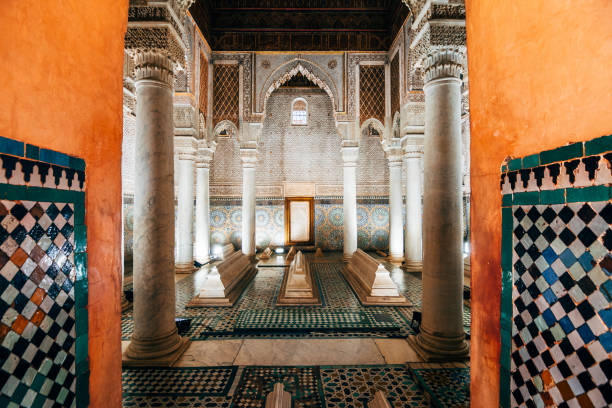
Ali ben Youssef Madrasa
The Madrasa was built by the Saadien Sultan Abdallah al-Ghalib in 1564 and the school took its name from the Almoravid Sultan Ali Ben Youssef. Though he had died 100 years earlier. The Madersa had capacity for over 900 students and students who weren’t from Marrakesh could board there. It is the largest Madrasa in all of Morocco.
Ticket prices : 20 dhs (2$)
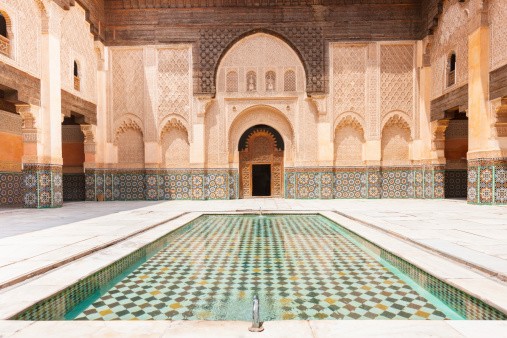
The Palmeraie
It’s the perfect place if you are looking for something different. The Palmeraie is a quiet area full of palms where you can experience some authentic activities like camel rides (cost 100 Dhs – 11$) or even quad bikes!. Do not hesitate to haggle over the price.
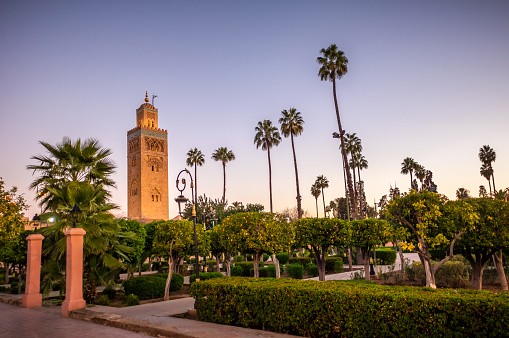
Majorelle Gardens
These beautiful gardens were built in 1929 by the French artist Jacques Majorelle a few years after he moved to Marrakesh. He also built a large workshop inside his villa there.
He created a botanical garden based on the Islamic gardens, the garden quickly became full of different varieties, becoming a refuge for hundreds of birds.
In 1937 he painted the walls of his villa with a unique blue colour, inspired by Moroccan blue tiles, and called the color ‘Majorelle Blue’.
In 1980, Yves Saint Laurent bought the house and made significant renovations.
At the gardens there is a Berber Museum, displaying a small collection of Irke pottery, artefacts, clothing and jewellery.
Over the years this beautiful villa has become one of the best attractions in Marrakesh, a haven of peace which is tended to daily by 20 gardeners.
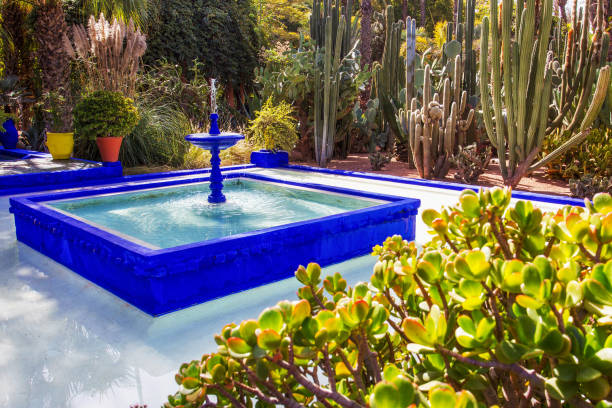
Menara Gardens
Menara Gardens are botanical gardens about a 45 minute walk away from Jemaa El Fna square. This peaceful place was planted with olive trees during the Almohad dynasty.
The artificial basin allows the irrigation of the surrounding gardens and orchard, and it is supplied with water by a 700 year old hydraulic system with water coming from the mountains located about 40 km south of the city.
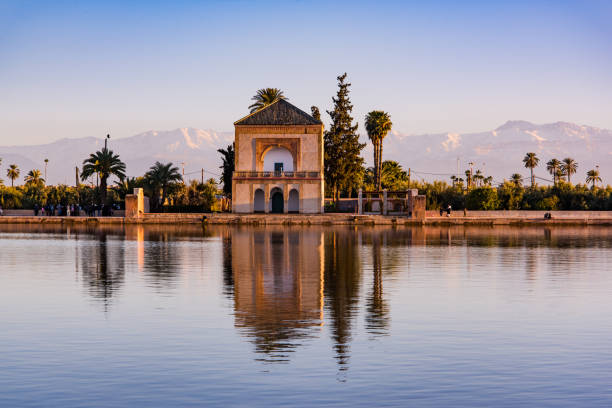
Marrakesh Museum
This museum, located near Ben Youssef mosque, was a palace built in the 19th century. The palace was restored by Omar Benjelloun, a Moroccan businessman and art collector.
You can find contemporary art exhibitions there and also Moroccan collectible copper, metalware, jewellry, coins, pottery and traditional Moroccan clothing.
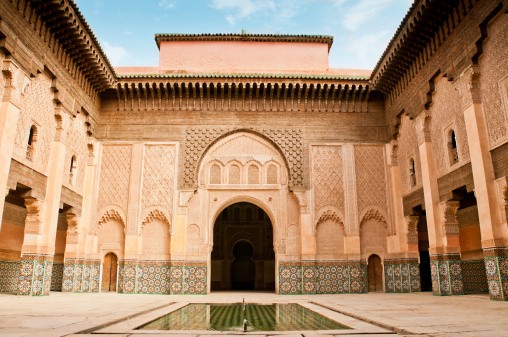
Dar Si Saïd
This is a little museum located to the north of the Bahia Palace, it’s more of a palace than a museum but you will find beautiful architecture and a collection of carpet, jewellry from all of Morocco plus Moroccan pottery and other artefacts.
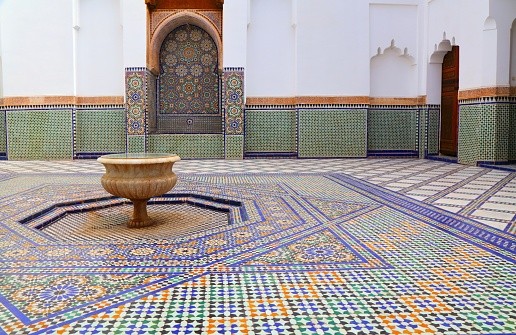
Festival of Popular Arts
Every year the festival runs for a week during the month of July. This music festival brings together a variety of local and foreign artists.
The festival takes place in various locations in Marrakesh such as Djemaa el Fna, El Badi palace, Dar El Bacha, the Royal Theatre and the Menara gardens.
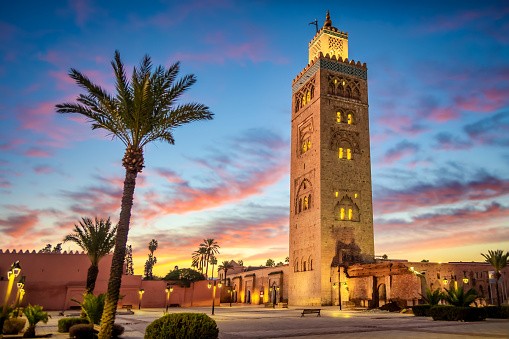
Rabat
History
In the current location of the Kasbah of the Oudayas, the Almoravids had created a fort to fight against the Berghouata tribes. This fort was replaced in 1150 by a Ribat (fortress) under the reign of the Almohad dynasty and became the gathering point for fighters going to Andalusia.
The caliph of Morocco, Yaqub al-Mansur, moved the capital of his empire to Rabat and started the construction of the Hassan tower which was supposed to be the biggest mosque in the world. He also transformed the Phoenician site of Chellah into a necropolis.
The city acquired the title, ‘Ribat al Fath’ (The Fortress of victory), to commemorate the Almohad victories.
At the end of the Almohad Dynasty and especially after Yaqub al-Mansur death (1199), the city began to decline, the Hassan tower construction work were stopped and the power shifted to Fez.
In 1609 the city experienced a significant growth when 13000 Moriscos settled in the city after being expelled from Spain.
The first inhabitants were from the city of Hornachos in western Spain and settled in the Kasbah. One year later in 1610, 10000 Andalusian settled in the low city and built a new enclosure, known as the Andalusian Wall.
The republic of Salé also known as ‘The republic of the Pirates of The Bouregreg’ became a city state from 1627 to 1668. The new inhabitants wanted revenge for their expulsion from Spain and piracy became the main source of income of the city. The pirates made long-distance raids as far away as Cornwall in the UK, Baltimore in Ireland and even Iceland.
The first governor of the city was Ibrahim Vargas. In 1624 Jan Janszoon, a Dutch origin who converted to Islam, became President and Grand Admiral of the Republic.
In the medina you can still find a street ‘Rue des Consuls’ which in where Western embassies used to be.
The republic became weak after many bloody clashes between the inhabitants of the Kasbah from the town of Hornachos, the Andalusians inhabitants of the lower town and the inhabitants of Salé.
In 1668, the Republic became under the control of the Alaouite dynasty.
In 1912, France established a protectorate in Morocco and Rabat became the capital of the country.
Rabat Travel Guide
Rabat is the capital of Morocco and second largest city in the country, after Casablanca. It is located on the Atlantic Ocean on the south side of The Bou Regreg river. On the opposite north bank of the river lies the city of Salé (Sala). Rabat is one of the fourth imperial cities of Morocco and many parts of the city are listed as UNESCO World Heritage Sites.

Getting there
By Plane
The Rabat International Airport is 9 kms away from the city center in the nearby town of Salé.
There is a choice of transport links from the airport to the Rabat centre available :
- Taxi : White taxis are available outside the airport, priced at 100 Dh.
- Bus : The cheapest way to the city take line No. 2, the bus station is located outside the airport next to the supermarket “Metro”, price of the bus ticket is 4 dh.
- Dedicated Stareo Bus : from the airport to the train station for 20 dh, Buses leave the airport one hour after each arrival and the departure from the train station to the airport is 2 hours before each flight. Travelling time is about 25 to 30 minutes.
By Train
There are two train stations in the capital, Agdal train station in the Agdal district and 3 km to the east is Rabat-Ville train station near the Moroccan parlement.
Major cities in Morocco are well connected by train. Travelling by train in Morocco is quite affordable. Travelling time is about 50min to Casablanca, 2 hours 40min to Fes, 4 hours to Tangier and just over 4 hours to Marrakesh.
By Bus
The city is well served by bus, the bus station is from Kamra bus station (Gare routière Kamra) : Avenue Al Fadila (near Avenue Kifah). The CTM company is there as are many other low cost companies. If you are travelling with ‘Supratours’ the bus station is situated at Agdal train station (gare ONCF Agdal).
Places to visit in Rabat
The Hassan tower
Built in 1195 under the reign of the Sultan Yacub Al-Mansour of the Almohad Dynsasty, this mosque was supposed to be the largest one in the World. After the Sultan’s death in 1199 the construction stopped. It was designed by Jabir ibn Aflah who designed two other famous mosques, Al Koutoubia Mosque in Marrakesh and the Giralda Mosque in Seville.
Due to the Lisbon earthquake in 1755, most of the 200 columns have fallen down. Next to the mosque you can visit a masterpiece of Moroccan architecture : the Mausoleum of Mohammed V. Built in 1971 it is a monument where King Mohammed V and his two sons the King Hassan II and the Prince Abdallah are buried.
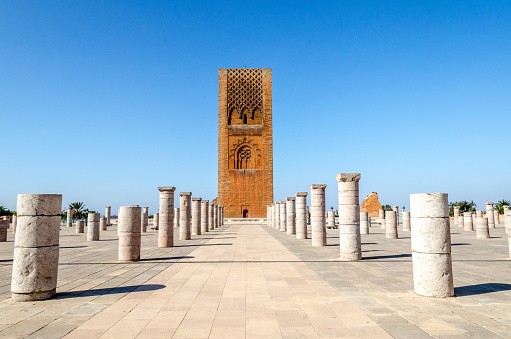
Kasbah of the Udayas
This fortress was built in 1150 and was the base from where the Moroccan army conquered Andalusia.
In 1833 the tribe was expelled from Meknes by the Sultan Moulay Abderrahmane. They settled in the Kasbah which bore their name. There is a museum inside the Kasbah next to Andalusian gardens where you will find Moroccan handcrafts, traditional jewelery, ornaments, traditional clothing, weapons and astrolabes (Arabic astronomy instrument).
Oudaia Museum is open everyday (except Tuesday) 9AM to 4:30PM.
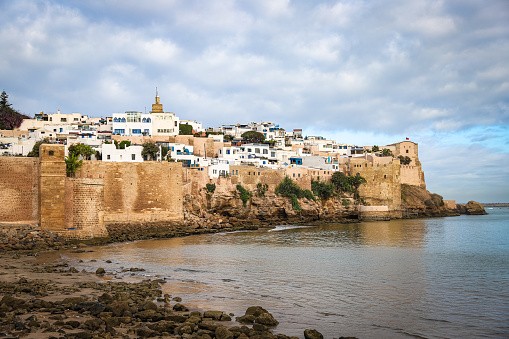
The Necropolis of Chellah
Chellah was a colony of different cultures: the Phoenicians, the Carthaginians and the Romans, You can actually see the ruins of the Roman town Sala Colonia. The excavations have revealed a forum, a large fountain, a triumphal arch and even a Christian basilica.
Chellah was abandoned for centuries until the Merinids chose the site upon which to build their necropolis. It is protected by a large enclosure which has three doors, the main door called Door of Sidi Yahia, the second door Bab Al-Bassatine ‘Gate of the Gardens’ and the last Bab Ain al-Janna the ‘The Source of Paradise’.
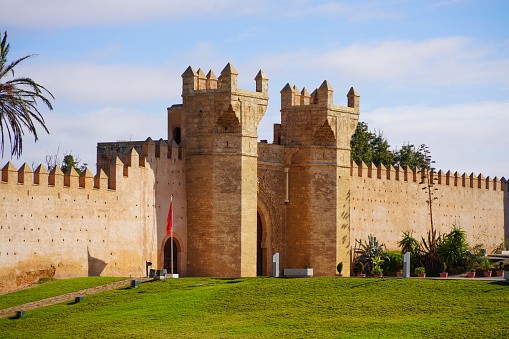
City walls of Rabat
Several successive city walls surrounded Rabat. The first one was built by the Almohad in the late twelfth century, the second by the Moorish of Andalusia in the early seventeenth century and the last one was built in the early nineteenth century by the Alaouite.
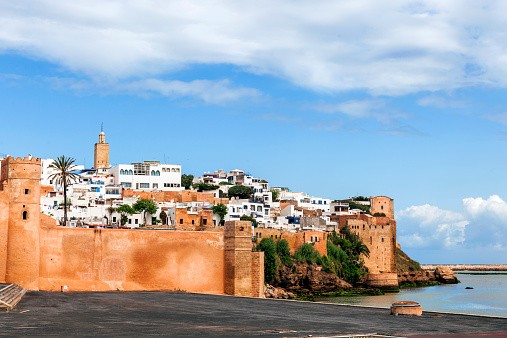
The Old Medina
The Medina (old town) was the place where the Moriscos (expelled Andalusian) settled in Rabat. They built a rampart (The Andalusian Rampart) inside the city as the Almohade enclosure was too big to defend effectively.
There are several gates to access the medina. The two main gates are Bab Al-Alou and Bab Al-Had on the west side of the Medina and on the south side there are two gates, Bab Bouiba and Bab Chellah.
The medina is full of life and history. Take a stroll around the historic centre, and admire the old houses and the traditional souks (market) where you can buy Moroccan crafts.
Not to be missed is the ‘Rue des Consuls’. This street is a listed monument and the street take its name from being the place where the consulates were situated when Rabat and Sale formed the Republic of Bou Regreg. Today there is several leather shops, artisans working wood and metals for jewellery and not to mention the authentic rbati carpet.

The New Marina
The Marina is relatively new. It is located in Sale along the river Bou Regreg where you will find a good selection of restaurants and cafes, with a breathtaking view of the city.
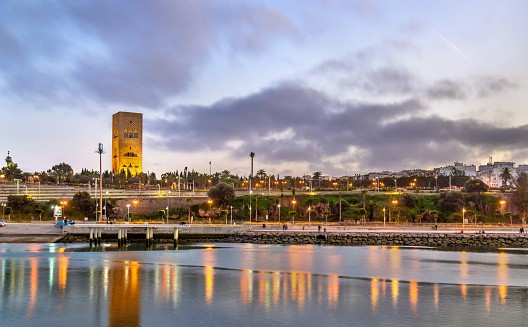
Bab Al Rouah
Bab Rouah is the most famous gate in Rabat, meaning ‘Gate of the Winds’ in Arabic. It was built during the Almohads Dynasty and was the main gateway to the city. It is located at the end of Victory Avenue and the gate has now become a beautiful contemporary art gallery.
Rabat Zoo
The new Rabat Zoo is located 8km from city center, it is the prefect place to spend a day with your family. You can see the Barbary Lion, also known as Atlas Lion, which is the world’s largest subspecies of lions.
Rabat Zoo’s opening times are 10 am to 4:30 p.m. (November to March) and 10 am to 6:30pm (April to October).
Museums
Mohammed VI Museum
The Mohammed VI modern and contemporary art museum is one of the largest museum’s in Morocco. It aims to collect and preserve national heritage. The museum is open daily from 10am to 6pm, closed on Tuesdays.
The museum is located at the corner of Avenue Moulah El Hassan and Avenue Allal Ben Abdellah.
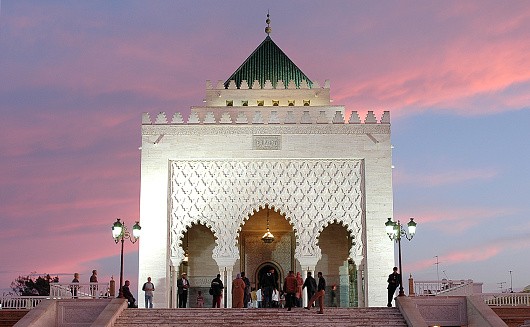
National Archaeology Museum
This museum (called in French, ‘Musée Archéologique’) was opened in 1932. It’s a major Moroccan archaeology museum covering pre-historic times and the pre-Islamic era. You will find an amazing collection of archaeological artefacts from the country including beautiful ceramics as well as artefacts from the Roman city of Volubilis.
Address : 23 Rue al-Brihi Parent, Opening hours 9am-4.30pm Wed-Mon
The Currency Museum
This museum is run by the National Bank of Morocco (Bank Al-Maghrib) and the museum features more than 1,200 coins, objects, money market instruments and bank notes. Another part of the museum features a collection of Moroccan and foreign artists paintings.
Address : Angle Avenue Allal Ben Abdellah and Rue Al-Qahira, Opening hours 9am-5:30pm Tue-Fri // 9am-12pm – 3pm-6pm Sat // 9am-1pm Sun
Festival
Mawazine Festival Rhythms Of The World
Mawazine is a music festival held annually in several different places within the city. The festival features many international stars from all around the world as well as local stars.
Meknes
History
The city was founded in the 9th century by the Meknassa tribe who had fled Kairouan in Tunisia. The Almohades destroyed the city to build a larger and more imposing city, between 1199 and 1213.
After the Almohads the Merinids built some Madrassas like Bou Anania in 1331 as well as also some mosques and Kasbah.
The Alawite Sultan Moulay Ismail began the construction of a great palaces, gardens, monumental gates and over 40 kilometers of walls 15 meters height.
He used at least 25,000 European slaves for the construction, kidnapped from European villages by Moroccan pirates. In 1696 the Sultan ordered the demolition of the El Badia Palace in Marrakesh to reuse materials in Meknes. The sultan chose Meknes as capital of his empire in 1672.
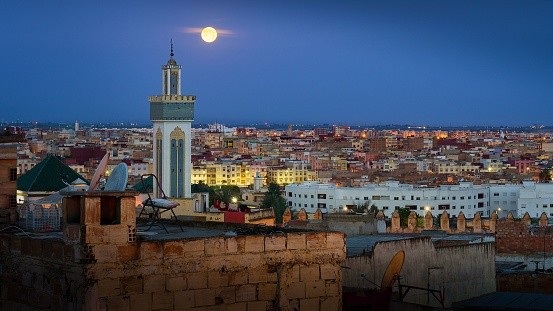
Places to Visit in Meknes
Meknes Medina
This medina is smaller than the one in Fes but it is cleaner and will charm you with its authentic atmosphere, many shops and great choice of restaurants.
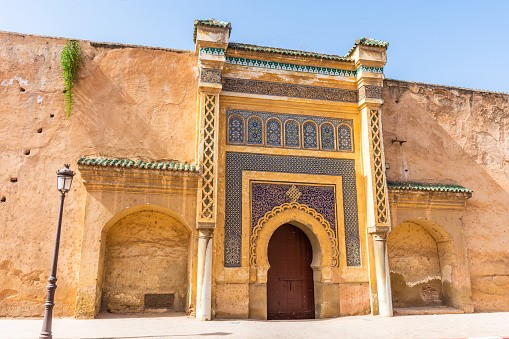
Bab Mansour Gate
This amazing gate was completed 5 years after Moulay Ismail’s death, during the reign of his son Moulay Abdellah in 1732. This is the main entrance of the Imperial Palace built for Moulay Ismail. The gate was named after the architect, El-Mansour, a Christian renegade who converted to Islam.
The marble columns that decorate the side bastions were taken from the Roman ruins of Volubilis.

Agdal basin
The Agdal basin is located 500m south of the Mechouar and the Royal Palace Mhensha. It is a large water storage tank located inside the Kasbah. It was built under the reign of Sultan Moulay Ismail in the early eighteenth century to serve as a strategic reserve of water and to irrigate the gardens and orchards in the city.
The basin has a trapezoidal plan and measures 319m long and 149m wide, with a depth that varies between 2m and 3.5m.
Hri Souani
Located some 500 meters south of the Royal Palace this monument dates back to Moulay Ismail in the early eighteenth century.
This is one of the prestigious historic monuments in Meknes. It groups a series of relatively cramped rooms around a spacious central hall of 26m long, 10m wide and 9m high. It was a place for food storage. It contains 10 rooms with ten well waterwheels. Water from these wells was used both for the building and for the basin.
Hri Souani was also the place where grain and hay were stored to feed Moulay Ismail’s 12,000 horses.
Mausoleum of Moulay Ismail
The mosque was built in 1703 by the Sultan Ahmed Eddahbi and became the mausoleum where Sultan Moulay Ismail (1645-1727) was buried along with one of his wives and two of his sons. This is one of the few religious buildings in Morocco open to non-Muslims.
The burial chamber is richly decorated and you can see the four Comtois clocks which were a gift from the King of France, Louis XIV, to the Sultan. Louis XIV wanted to be forgiven after refusing to give his daughters in marriage to Moulay Ismail.
Bab al Khmis
Originally Bab el Khmis was the western part of ‘Madinat al-Riad al Anbari’ (City of the Amber garden), a sumptuous city built under the reign of Moulay Ismail in favor of his Oudatas army and for important people. His successor Moulay Abdellah destroyed this part of the building in 1731.
Bab Berdaine
The gate is in the extreme north of the ancient city and stands on top of a hill. Its exterior is in the same style as the monumental gates of Meknes. Its decorated part is very similar to that of Bab Khemis.
Qara Prison
Qara was a Portuguese architect and prisoner and this ancient prison is located inside the Ismaili Qasba, near the Ambassador’s lodge. The monument was built in the early eighteenth century. It is a vast underground area consisting of three rooms composed of a series of arches resting on pillars with an average size of 140cm by 3 m 46cm, and supporting barrel vault loaders.
Dar Jamaï
Built during the time of Sultan Moulay El Hassan I in 1882, it was the residence of his Vizier, Abou Abdellah El Jamaï. This building was converted into a museum in 1958. Originally it included a bath, a slaughterhouse, shops and a fondouk (place or store of goods, animal housing and a place to accommodate merchants and travelers).
Currently, there is only the noble part and annexed housing remaining. The building is characterized by an Andalusian type garden (Riad) with pathways of zellige, fruit trees and flowers.
Near Meknes
Volubilis
The Mauritanian capital, founded in the 3rd century B.C., became a Roman city and quickly grew, exceeding an area of 40 hectares. The historical site is located 40 minutes by car, 31km north of Meknes.
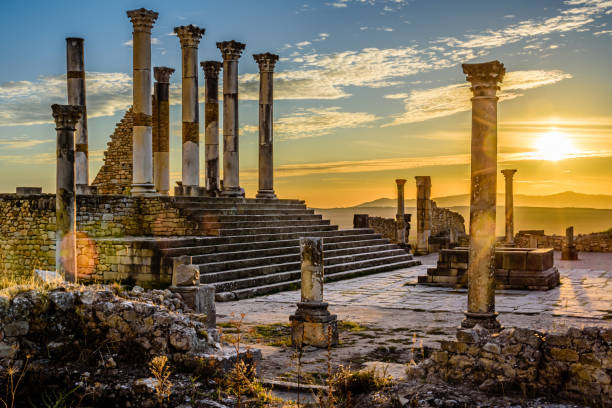
Moulay Driss Zerhoun
Just 4km from Volubilis, Moulay Driss Zerhoun is a small town over two hills at the base of Mount Zerhoun. In 789, it was here that Moulah Idriss I arrived, bringing with him the religion of Islam. He is also buried in the town.
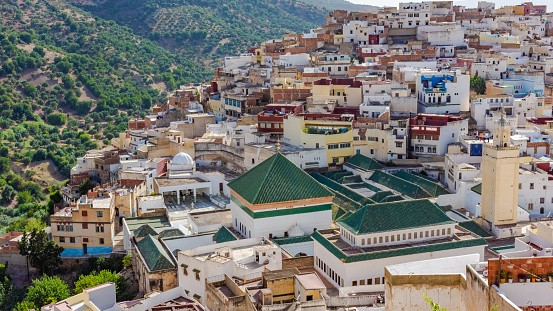
Why You Should Visit the Imperial Cities of Morocco?
The four Imperial Cities of Morocco are Fez, Marrakesh, Meknes, and Rabat. Each played an important role in the history of Morocco. And each has plenty to offer to visitors looking to learn more about this incredible country. Do you prefer to travel independently? If not, there are a number of wonderful Imperial City tours available.
When planning your Morocco vacation, contact us to plan for your Morocco Cities Tours and customize your Morocco Tours
Plan your trip to Morocco
Chat with a local specialist who can help organize your Lovely Morocco Tours
